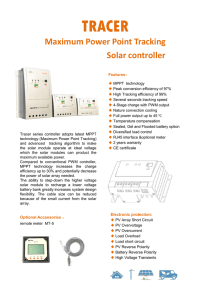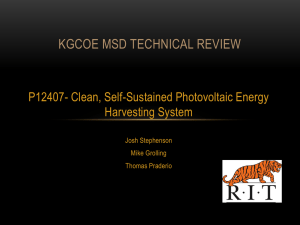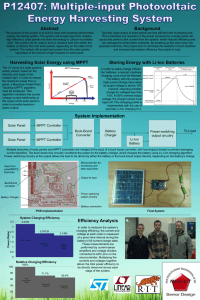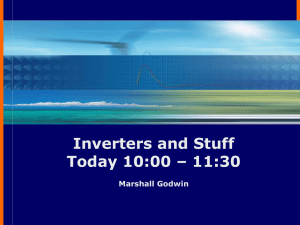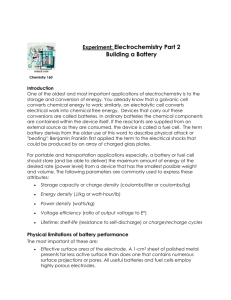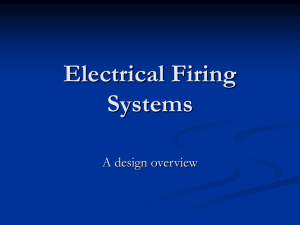Solar Panel Background
advertisement
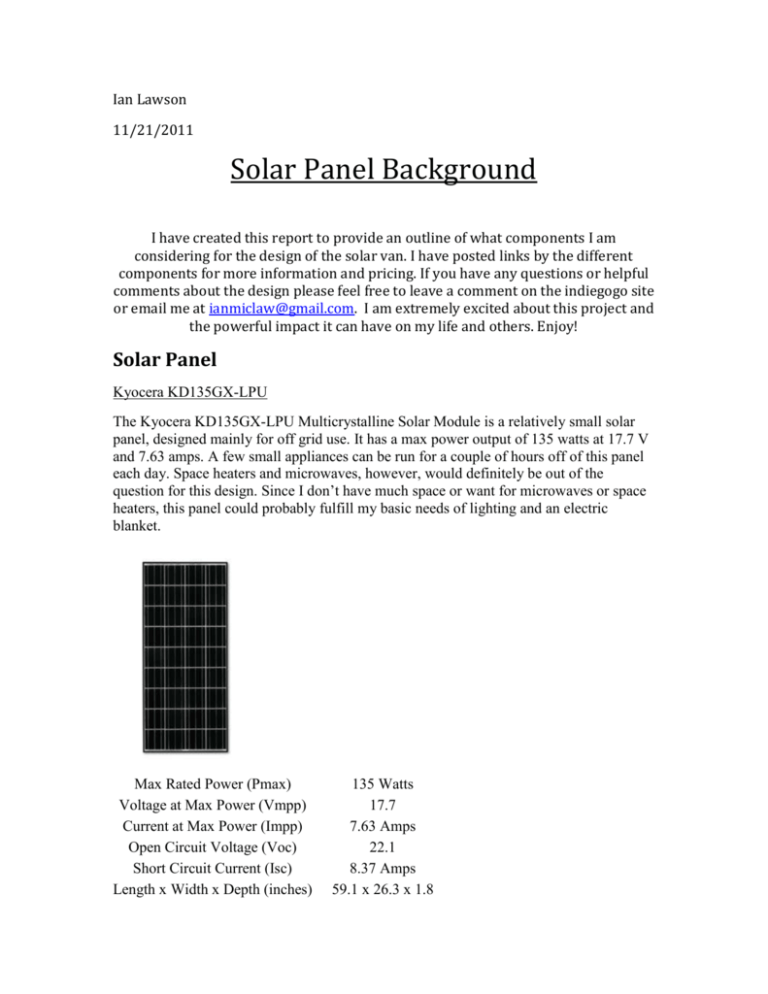
Ian Lawson 11/21/2011 Solar Panel Background I have created this report to provide an outline of what components I am considering for the design of the solar van. I have posted links by the different components for more information and pricing. If you have any questions or helpful comments about the design please feel free to leave a comment on the indiegogo site or email me at ianmiclaw@gmail.com. I am extremely excited about this project and the powerful impact it can have on my life and others. Enjoy! Solar Panel Kyocera KD135GX-LPU The Kyocera KD135GX-LPU Multicrystalline Solar Module is a relatively small solar panel, designed mainly for off grid use. It has a max power output of 135 watts at 17.7 V and 7.63 amps. A few small appliances can be run for a couple of hours off of this panel each day. Space heaters and microwaves, however, would definitely be out of the question for this design. Since I don’t have much space or want for microwaves or space heaters, this panel could probably fulfill my basic needs of lighting and an electric blanket. Max Rated Power (Pmax) Voltage at Max Power (Vmpp) Current at Max Power (Impp) Open Circuit Voltage (Voc) Short Circuit Current (Isc) Length x Width x Depth (inches) 135 Watts 17.7 7.63 Amps 22.1 8.37 Amps 59.1 x 26.3 x 1.8 Weight of Panel (Pounds) Connector Cable Type 28.7 MC4 Latching Cables Kyocera KD235GX-LPB The Kyocera KD235GX-LPB Polycrystalline Solar Module can produce 235 watts. It is mainly used for grid tie design but can also be used with battery systems as long as you use an MPPT (maximum power point tracking) charge controller to take it from 24 V to 12 V direct current. This system could output more power than I need in the summer but it may be perfect for the winters low light. Below is a list of Kyocera solar panels and there specifications. http://www.solar-electric.com/ Inverter An inverter will be needed in order to take the battery voltage (standard 12V) and direct current and convert it into 120 V alternating current. Standard appliances can be plugged into the inverter to draw power from the battery. Samlex America Heavy Duty The Samlex America Heavy Duty Industrial Pure Sine wave Inverter model S-300124 has an input voltage ranging from 21-30 VAC. It produces 110 VAC up to 300 watts with a surge of 400 watts. This inverter would be better for higher voltage inputs from two 12 V batteries in series. The following list is a compilation of Samlex 12V inverters with power rating from 150 watts to 1000 watts. Depending on the solar panel chosen for this design an inverter can be selected from this list to mach the power output of the Panel. 12V inverters would use one 12V battery or multiple batteries in Parallel. More information and options for inverters can be found at http://www.altestore.com/store/Inverters/Off-Grid-Inverters/c559/ Regulator A regulator, or charge controller, sets the current and voltage input to the battery. It does this in order to maximize the energy the solar panel is collecting. Without a charge controller a lot of the power is lost due the voltage step down. The voltage coming into the battery needs to be 12V or very close to that. By simply stepping the voltage from the panel down to 12V without changing the current, you can lose 35% of your power. An MPPT (maximum power point tracking) charge controller takes data from the battery and the solar panel and finds the perfect Voltage and current to charge the battery. It does this continuously so as the sun changes and the battery charges, it can still deliver the best possible combination. http://www.windsun.com/ChargeControls/MPPT.htm Solar Boost 2000E MPPT Solar Charge Controller The Solar boost is a MPPT type charge controller for 12V systems up to 25 amps. This specific charger would be good for any panel rated for fewer than 210 watts. The display gives indicates battery voltage, solar panel current and output charge current. There is also a LED charge indicator that tells if it is charging or if the battery is fully charged. If a smaller solar panel is selected this would be the ideal charge controller. http://www.solar-electric.com/sb2000.html Morningstar SS-MPPT-15. The Morningstar SS-MPPT-15 is a 15 Amp, 12 or 24 Volt MPPT Solar Charge Controller. It is able to accommodate larger solar panels that output 24V. If I decide to go with a larger panel this is the suggested controller. http://www.solar-electric.com/mosumpsochco.html Battery There are many different types of batteries to choose from for this project, however, some are a little more advantageous than others. For most solar applications deep cycle batteries are used. These are different than car batteries which are made to pump out lots of power in a little time. Deep cycle is better at smaller power outputs over time in addition to being able to handle lower charges. Car batteries can be ruined if they are fully drained, unlike deep cycle which can go from uncharged to charged, many times in its life. The current design of the solar system has all of the components except the panel inside the cabin of the van. Normal batteries emit flammable hydrogen gas and are full of very harmful sulfuric acid. New battery designs called AGM, or absorbed glass mat batteries, are much safer than ordinary batteries. The Boron-silicate glass is 95% saturated with acid so even if the battery is broken no acid can leak out. The hydrogen and Oxygen produced inside also recombine into water while charging so no harmful gasses are emitted. For my purposes in the van an AGM battery is necessary to keep me safe as well as provide power. http://www.windsun.com/Batteries/Battery_FAQ.htm#AGM, or Absorbed Glass Mat Batteries With my two LED lights pulling about 28 watts as well as a 60 watt heating blanket, I should be using under 10 amps per night. However there may be nights when I need to run my computer or charge my phone. Additional devices may be added to the van that will pull more power from the battery. It is also not a good idea to completely discharge the battery. Given all of this I figure it would be best to have at least a 90 Amp-hr AGM battery, such as the one below. Depending on funding I may be able to get a bigger battery but this will probably suit all of my needs and then some. The battery brand will be chosen based on what is available locally.

